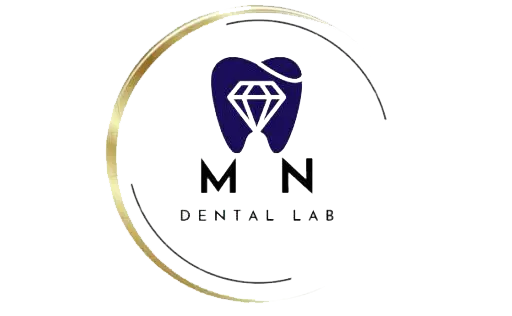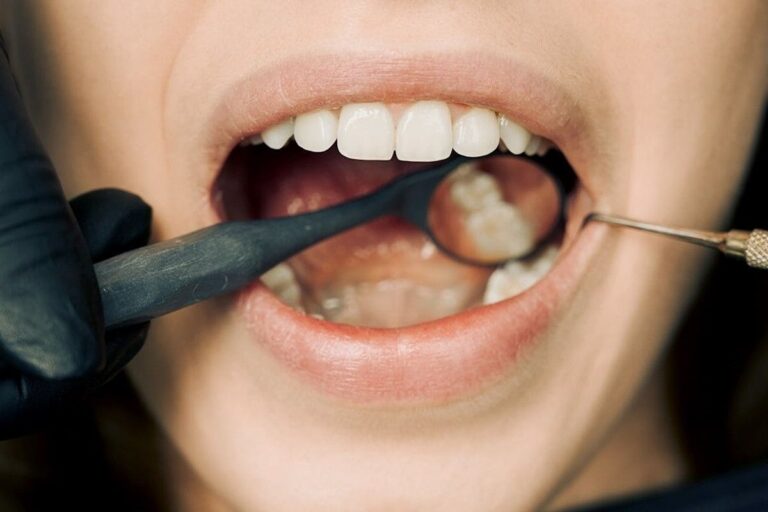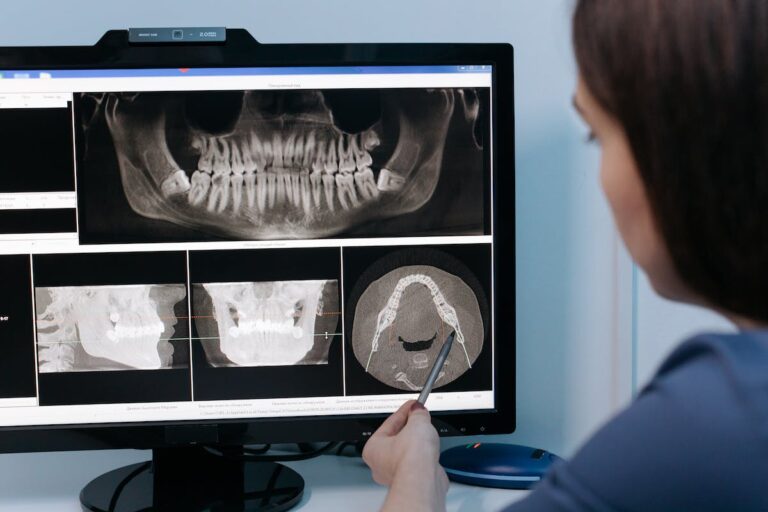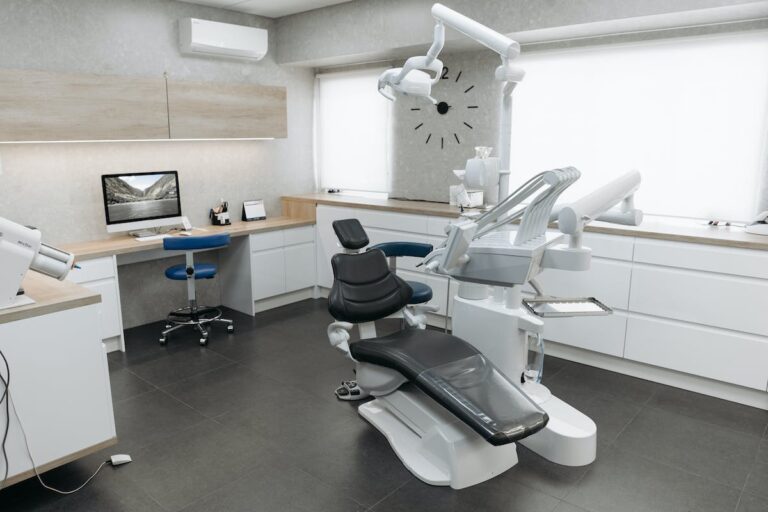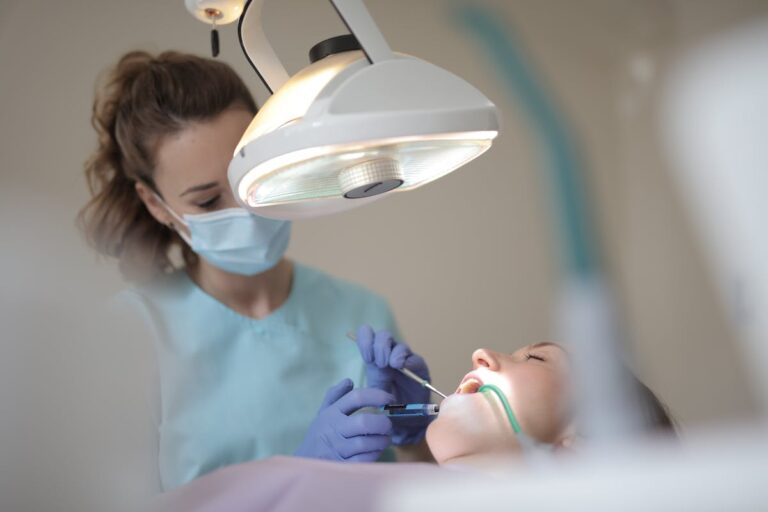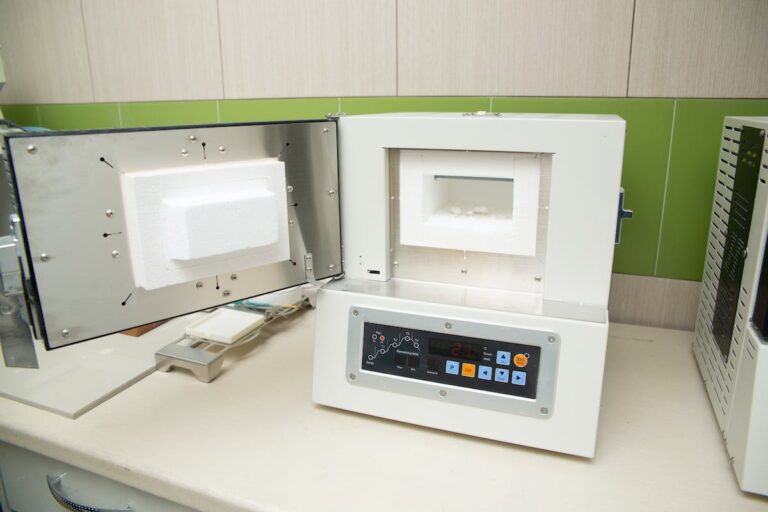Advanced dental technology integration significantly transforms patient care and treatment outcomes. Digital impression precision and 3D printing customization capabilities increase procedural efficiency and patient satisfaction. Laser dentistry advancements, teledentistry’s global reach, and AI’s potential in diagnostic accuracy reshape dental care’s future. These technological successes establish new dental health service standards, offering insights into their implications and benefits.
Digital Impressions Revolution
Digital impressions in dentistry, through advanced scanning technology, create accurate 3D images of patient’s teeth, improving diagnosis, treatment planning, and user comfort. This process is faster, more precise, and more comfortable than traditional methods which can be inconsistent and error-prone. Dental practices benefit from streamlined workflow with immediate access to digital data, reducing appointment duration. The ease of sharing digital impressions with dental laboratories ensures accurate fabrication of dental restorations and improves the efficiency of treatment from diagnosis to prostheses delivery.
The Rise of 3D Printing
3D printing’s advent in dentistry significantly advances materials science and solution customization. Enhanced 3D printing materials now facilitate durable, biocompatible dental appliances production, catering to individual patient needs. This technology also boosts production speed, improving efficiency and patient satisfaction.
3D Printing Materials Innovation
3D printing’s material innovation significantly evolves dental technology, enabling precise, custom patient care. The progress involves not just shaping materials into dental tools and implants, but also refining their composition and properties. A key focus is material durability, ensuring that dental applications fit perfectly and last under daily use. Additionally, environmental impact of these materials is being intensely examined. The goal is to lessen waste and energy use in production, favoring recyclable and biocompatible materials. This dual focus on durability and sustainability highlights the holistic development strategy for new dental materials, forecasting a future of advanced, environmentally conscious dental care.
Custom Dental Solutions Enhanced
3D printing advancements revolutionize custom dental solutions, providing precise and adaptable patient care. This technology enhances material biocompatibility in dental prosthetics and implants, ensuring safety, durability, and natural mimicry. 3D printing in dentistry expands patient customization, allowing for unique anatomical feature-based dental devices. This promotes better fit, comfort, and functionality, improving patient satisfaction and outcomes. The analytical material selection and design customization highlight modern dental practice sophistication.
Speeding Up Production Times
3D printing technology in dentistry streamlines production, enhances efficiency, and reduces patient waiting times. This method surpasses efficiency metrics by accelerating custom dental solutions. Dental professionals, by integrating 3D printing, optimize workflow and concurrently produce multiple dental pieces. This innovation elevates patient satisfaction, represents a paradigm shift, sets a new operational efficiency benchmark, and underscores technology’s role in healthcare evolution for superior outcomes.
Laser Dentistry Breakthroughs
Laser dentistry elevates dental care through painless procedures and precision. By utilizing focused light beams, it enhances efficiency, minimizes discomfort, and decreases recovery times. This dental innovation shifts towards patient-friendly, accurate treatments, setting new oral health care standards.
Pain-Free Procedures
Innovative laser dentistry techniques revolutionize dental care by providing pain-free procedures, enhancing patient comfort and efficiency. This advancement relates to the evolution of anesthetic techniques and the diversification of sedation options, both designed to reduce discomfort and anxiety. Laser technologies enable precise treatment targeting, limiting invasive cuts and decreasing the need for traditional anesthetics. The refinement of sedation options, from mild to comprehensive, ensures patients experience minimal distress during potentially discomforting procedures. This progression in laser dentistry and anesthetic practices signifies a shift to patient-centric dental care.
Precision in Treatment
Laser dentistry advancements boost precision in dental treatments. This technology targets interventions, sparing surrounding tissues, and improving procedure accuracy. It aids in anxiety management by offering less invasive methods, thus lessening traditional sedation reliance.
Key points: – Reduced tissue damage: Precise targeting conserves adjacent areas. – Decreased bleeding: Improved coagulation reduces bleeding risks. – Faster healing: Less trauma accelerates recovery. – Pain mitigation: Minimally invasive procedures decrease discomfort, affecting sedation requirements. – Anxiety control: Less daunting procedures mitigate patient fears, diminishing sedation dependency.
Teledentistry’s Global Impact
Globally, teledentistry enhances dental care accessibility, especially for remote communities. It utilizes digital communication for consultations, diagnosis, and some treatments, reducing travel needs and increasing convenience. Regulatory barriers, varying laws, and telehealth regulations present challenges to teledentistry integration. Issues such as scope of practice, licensure requirements, and reimbursement policies differ regionally. Patient privacy is a critical concern due to the transmission of sensitive data online. Dental practices need strong cybersecurity and compliance with regulations like the US’s HIPAA to protect patient information. Despite these obstacles, teledentistry’s global influence in making dental care more accessible and efficient is noteworthy, provided regulatory and privacy concerns are well-managed.
AI in Diagnostic Accuracy
AI’s advent in diagnostic accuracy revolutionizes dental technology, notably in X-ray interpretation enhancement. AI-driven predictive analytics now forecast dental issues pre-escalation, fostering proactive prevention. AI integration in treatment planning also boosts efficiency and precision, benefiting dental professionals.
Enhancing X-Ray Interpretation
AI’s role in enhancing x-ray interpretation has revolutionized dental healthcare diagnostics. The integration of AI algorithms allows dental professionals to deliver precise diagnoses, directly impacting patient care. Key aspects of dental radiography such as radiation safety and image storage have also seen improvement, with optimized exposure levels and efficient data management.
- Anomaly Detection: AI swiftly identifies irregularities, reducing human error.
- Radiation Safety: AI protocols minimize radiation exposure, enhancing patient safety.
- Image Storage Solutions: AI enables efficient data encoding and retrieval, streamlining workflow.
- Interpretation Consistency: AI reduces variability in diagnostic outcomes.
- Immediate Feedback: AI facilitates real-time insights, expediting decision-making.
This represents a transformative shift in dental diagnostics, leading to safer, efficient, and accurate patient care.
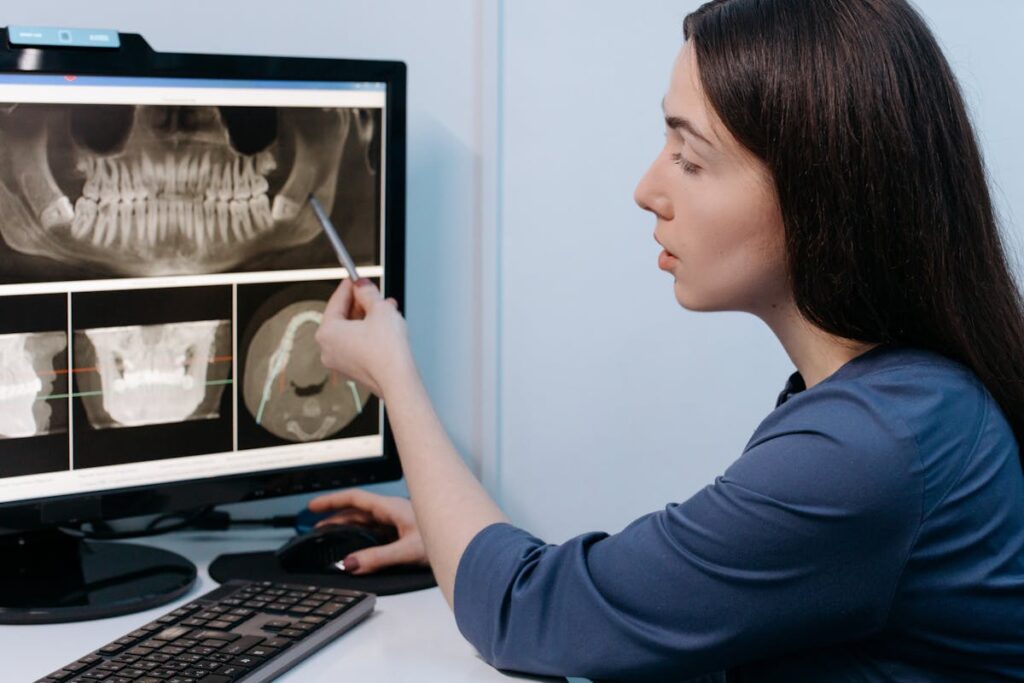
Predictive Analytics for Prevention
Predictive analytics in dental care significantly improve diagnostic accuracy and patient outcomes. These algorithms analyze large datasets, identify patterns, and predict potential dental problems for early intervention. This technology streamlines diagnosis and informs decision-making for dental professionals. Insurance partnerships provide access to broad datasets and financial models supporting preventive care. Predictive analytics also educate patients about dental health risks and promote preventive measures. This combination of technology, insurance, and education transforms dental care, making prevention more attainable.
Streamlining Treatment Planning
Artificial intelligence advancements refine dental diagnostic accuracy, streamlining treatment planning. This technology precision enhances diagnoses and improves operational efficiencies in:
- Automated dental image analysis for quicker, accurate diagnoses.
- Improved patient communication tools for clear treatment plan explanations.
- Efficient appointment scheduling systems for optimal time and resource utilization.
- Predictive treatment planning for personalized care strategies.
- Practice management software integration for seamless diagnosis to treatment operation.
Smart Toothbrush Advancements
Smart toothbrushes, incorporating advanced sensors and artificial intelligence, have transformed dental care by offering personalized feedback to optimize brushing techniques. Their extended battery life provides reliability and user convenience, reducing charging frequency and making them suitable for both home and travel use.
Furthermore, app integration is a key advancement in smart toothbrush functionality. These apps utilize toothbrush sensor data to analyze brushing habits including duration, pressure, and coverage. This real-time feedback allows users to modify their techniques for effective cleaning, enhancing oral health. Features like brushing history tracking, personalized recommendations, and brush head replacement reminders promote an informed approach to dental care.
Intraoral Cameras Unveiled
Intraoral cameras, boasting compact design and high-resolution imaging, have transformed dental diagnostics. This technology increases diagnostic accuracy, improves dentist-patient communication, and optimizes workflow. Important aspects include user comfort and maintenance costs.
- High-resolution imaging aids early problem detection, ensuring accurate diagnosis.
- Real-time visual feedback enhances patient engagement and oral health understanding.
- Lightweight, ergonomic design improves user comfort, reducing strain for dentist and patient.
- Durable design and ease of use reduce maintenance costs compared to traditional equipment.
- Digital record keeping aids in tracking patient progress, enhancing continuity of care.
CAD/CAM Technology Transformation
CAD/CAM technology has revolutionized dentistry by enabling precise, rapid production of custom dental restorations. This transformation is driven by advanced software integration and technician training.
Software integration in CAD/CAM systems ensures accurate data transfer, resulting in precise physical restorations from digital impressions. The software’s continuous evolution incorporates advanced algorithms and machine learning, enhancing precision and predictability in dental restorations.
Technician training is key to CAD/CAM successful adoption, providing dental technicians with comprehensive knowledge of CAD/CAM system’s software and hardware. This education allows technicians to fully leverage the technology, producing high-quality dental restorations.
Virtual Reality Training Tools
Virtual Reality (VR) tools advance dental education and practice by providing immersive, customizable learning experiences that enhance skill acquisition, manage simulation sickness, and offer feedback and assessment.
VR tools in dentistry offer immersive learning by simulating realistic environments for practice, minimizing patient interaction risks during learning. Customizable VR content creation enables the development of tailored scenarios, simulating a wide array of dental procedures. Interactive VR training expedites the learning process, facilitating hands-on experience in a controlled environment.
Advanced VR solutions mitigate simulation sickness, ensuring comfortable user experience. VR training tools further include real-time feedback and performance analytics, aiding in continuous skill enhancement.
VR training tools are pivotal in dental education, fusing technology with practical learning effectively.
Enhanced Orthodontic Solutions
Dental technology advancements have transformed orthodontic solutions, enhancing precision and customization in treatment planning. Digital imaging and 3D printing integration has elevated treatment accuracy, improving patient outcomes and satisfaction. Clear aligner technology development has revolutionized orthodontic aesthetics and comfort, making it a popular choice.
Orthodontic gamification, a novel innovation, uses game-like elements for patient motivation. It encourages adherence to treatment plans, especially in younger patients, through rewards and interactive challenges. This has significantly increased patient compliance and engagement, contributing to effective treatment outcomes.
Advanced retention strategies ensure orthodontic results longevity. Customized retainers, developed from precise digital scans of patient’s teeth, maintain post-treatment alignment. The focus on retention guarantees lasting orthodontic treatment benefits, preserving smile health and aesthetics.
Robotic Surgical Systems
Robotic surgical systems in dentistry have transformed surgical procedures and training methods, yielding improved patient outcomes. These systems utilize cutting-edge technology for precise execution of complex dental surgeries, reducing recovery time and enhancing patient comfort.
Key benefits include:
- Precision: Robotics enable accurate incisions, limiting tissue damage.
- Training: High-fidelity simulations improve trainee skill sets, safeguarding patient wellbeing.
- Comfort: Robotics facilitate minimally invasive techniques, expediting recovery.
- Reliability: Automation minimizes manual errors, ensuring consistent results.
- Personalization: Advanced software supports tailored surgical planning based on individual patient anatomy.
Real-Time Patient Monitoring
Dental technology advancements have birthed real-time patient monitoring, enhancing care quality and treatment precision. This innovative approach utilizes sophisticated sensors and wearable devices, integrated with dental practices, for continuous vital signs and health indicators tracking. This breakthrough enhances diagnostic accuracy, improves patient outcomes through early detection of potential complications, and presents significant patient privacy challenges.
Wearable technology integration into dental care provides real-time data crucial for decision-making in complex procedures. However, it necessitates stringent data protection measures for sensitive health data, ensuring confidentiality and regulatory standards compliance.
Ultimately, successful real-time patient monitoring systems implementation in dentistry hinges on balancing better care through technology with patient privacy safeguarding. This balance requires robust encryption methods and secure data transmission protocols to prevent unauthorized patient information access. As dental practices grapple with these complexities, wearable integration’s potential in transforming patient care continues to surface, denoting a significant dental technology evolution milestone.
Frequently Asked Questions
How Have Advancements in Dental Technology Impacted the Environmental Footprint of Dental Practices?
Dental technology advancements have lessened environmental impact via green dentistry, promoting waste reduction and resource efficiency. This move to sustainability indicates a commitment to reducing dental care’s ecological footprint.
What Are the Ethical Considerations Surrounding the Use of AI and Robotics in Dental Procedures?
AI and robotics’ use in dental procedures raises key ethical considerations, primarily informed patient consent and data privacy safeguarding. These technologies demand a unique approach to effectively address potential ethical dilemmas.
How Do These Technological Advancements in Dentistry Affect the Affordability and Accessibility of Dental Care for Low-Income Populations?
Advanced dental technologies, while improving precision and patient understanding, may intensify technological inequities. This can limit affordability and accessibility for low-income groups due to the higher costs of these technologies.
What Are the Long-Term Effects on Dental Professionals’ Job Security and Skill Requirements Due to the Automation and Digitization of Dental Procedures?
Automation and digitization’s long-term impact on dental professionals’ job security and skill requirements necessitates career evolution and educational adaptation. Integration of new technologies enhances efficiency, demanding advanced technical proficiency.
How Do Cultural Perceptions and Acceptance of These Advanced Dental Technologies Vary Across Different Regions or Countries?
Cultural norms and values influence the variation in technology resistance across regions, directly affecting the acceptance and use of advanced dental technologies. This disparity guides their worldwide distribution and adoption strategies, crucial for semantic search optimization and natural language processing.
